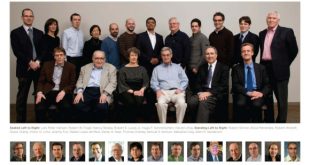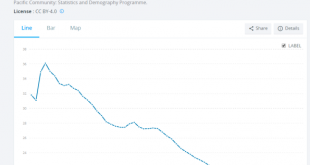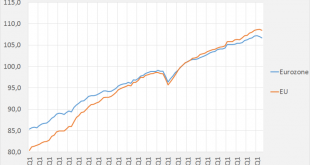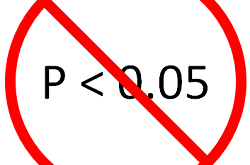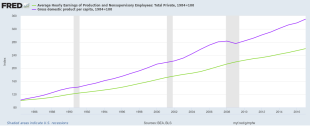from Lars Syll The fallacy of composition basically consists of the false belief that the whole is nothing but the sum of its parts. In the society and in the economy this is arguably not the case. An adequate analysis of society and economy a fortiori can’t proceed by just adding up the acts and decisions of individuals. The whole is more than a sum of parts. This fact shows up when orthodox/mainstream/neoclassical economics tries to argue for the existence of The Law of Demand – when...
Read More »Ti auguro Buon Natale e un felicissimo Anno Nuovo
Productivity in the Eurozone (and why it matters)
@Brankomilan leads us to this (french) piece about Austria. It states that the Austrian government enacted a new law which authorizes working days of 12 hours and working weeks of 60 hours. A). This is a clear case of retrogression. It’s good to read what, in 1921, the International Labor Office stated in its first annual report: ““It would therefore be almost impossible to exaggerate the truly revolutionary character of the events which during the last years of the war or after the war...
Read More »Recession risks for the United States in 2019
from Dean Baker As we reach the end of the year, the economic recovery in the United States is approaching a new record for duration. In June, it will have its tenth birthday, passing the 1990s recovery as the longest one in US history. While recoveries do not die of old age, they do die. The length of this recovery has many looking for recession prospects on the horizon. At the moment, they are not clearly visible. Before examining the risks, it is worth saying a bit about the good news....
Read More »Why statistical significance is worthless in science
from Lars Syll There are at least around 20 or so common misunderstandings and abuses of p-values and NHST [Null Hypothesis Significance Testing]. Most of them are related to the definition of p-value … Other misunderstandings are about the implications of statistical significance. Statistical significance does not me an substantive significance: just because an observation (or a more extreme observation) was unlikely had there been no differences in the population does not mean that the...
Read More »Ivy Leagues are handing out millions in fees to hedge fund managers
from Dean Baker Many of the richest people in the country make their fortune in the financial sector. While it is surely the case that many of the high rollers in the financial sector are hard working and intelligent, these traits are not the key to getting really rich in the modern economy. As has always been the case, nothing can beat being well connected. The latest tale of the well-connected rich is a study, by Markov Processes International, of the 10-year returns of the endowments...
Read More »Why all models are wrong
from Lars Syll Models share three common characteristics: First, they simplify, stripping away unnecessary details, abstracting from reality, or creating anew from whole cloth. Second, they formalize, making precise definitions. Models use mathematics, not words … Models create structures within which we can think logically … But the logic comes at a cost, which leads to their third characteristic: all models are wrong … Models are wrong because they simplify. They omit details. By...
Read More »Measure for measure*
from David Ruccio No matter how we measure it, most Americans are falling further and further behind the tiny group at the top. That’s not at all surprising. Whether we compare the growing gap between average wages and Gross Domestic Product per capita (as in the chart on the left) or real median household income and real Gross Domestic Product per capita (as in the chart on the right), it’s clear the average American has been losing out. A growing proportion of what workers produce...
Read More »Gr**th and G*P: don’t mention the G-Words
from Geoff Davies The recent exchange between Jason Hickel (and here and here) and Dean Baker (and here) on whether humanity can have a viable future and still have ‘economic growth’, nicely highlights the way old concepts and words can trap us in unproductive debate and action. The way forward is to recognise the need for a fundamental re-framing of the nature and purpose of our societies, and their economies. The terms growth, GDP, capital and capitalism are so ill-defined, confused or...
Read More »“Wageless growth” not “Jobless growth” the new conundrum
from C. P. Chandrasekhar The so-called ‘synchronised recovery’ that global policy makers periodically refer to, seems to have bypassed much of the world’s working people. According to the just released Global Wage Report 2018/19 of the International Labour Organisation (ILO), the rate of growth of average monthly earnings adjusted for inflation of workers across 136 countries registered in 2017 its lowest growth since crisis year 2008, and was well below figures recorded in the pre-crisis...
Read More » Real-World Economics Review
Real-World Economics Review

